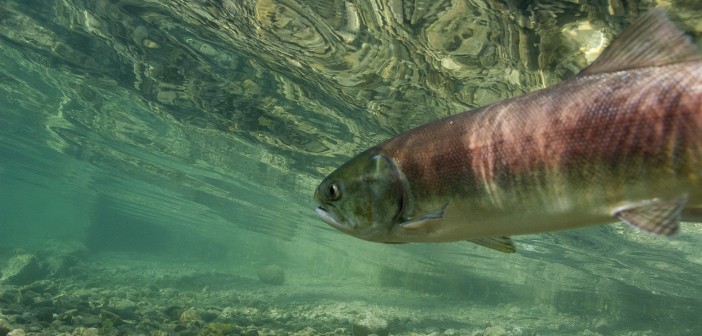North American salmon live on the northern Atlantic coast and on the northern Pacific coast from Alaska to central California, stretching as far inland as the Mackenzie River in Canada’s tundra region. Salmon have also been introduced in all five of the Great Lakes in more recent years. While born in freshwater, most species migrate to the sea and return to their exact spot of hatching to spawn themselves- they remember the way and the spot by incredible “smell memory” abilities. There are six American species: Atlantic, Chinook (King), Coho (silver), chum, pink, and sockeye (red). Most will feed on small fish, krill, shrimp, and other small water creatures. Their red or orange color is due to carotenoids in the krill. Salmon are fun to catch and healthy to eat, having a lot of protein, vitamin D, and omega3 in their fat cells. Salmon hatcheries “ranch” young fry and release them into rivers where they can often be freely fished (provided you have an in-state fishing license). Alaska’s new system releases fry direct into the ocean and the adult fish return later on to the release-point where they can be caught by anglers.
While catching a salmon on your line costs you more than just buying one in the store on average, the up side of this is that for this very reason coastal and estuary salmon fishing areas are often legally reserved for recreational rather than commercial fishermen since the former circulates more money in the economy. There are a number of ways to fish for salmon, often depending on which species is sought and whether you are fishing the coast, estuaries, or lakes. Some tips are given below.
The word mooching is familiar to us with the meaning of strategically gaining free meals, but in salmon lingo, it is the process of moving your bait up and down in the water column until you attract a bite. Mooching is often done in motor-less drift fishing on the ocean. Tips for “moochers” include keeping your line at a 45 degree angle with the boat to avoid tangles, and using a specialized miter box to make angled cut in a herring or small bait fish. The beveled shape of the herring will cause it to twist and turn on the way up and down in the water, increasing your chances of finding where the fish are at, both as to area and depth.
Jigging is similar to mooching, but a tad bit different. A fish-shaped salmon jig is used instead of real bait, and a shorter and stiffer rod is needed. If fishing straight down (vertically), simply move the pole up and down at the desired depth. But if you want to cast out horizontally and jig, there is a trick to making the the jig rise and fall correctly. To make it rise, pull the rod toward you; to make it fall, push it back away and reel in the slack.
Fly fishing is especially good for coho salmon, though it works for other species as well. A small, lightweight, often feathery fly will resemble some kind of insect or small water-dwelling creature on which salmon, being carnivorous, love to feed. According to All Rivers & Saltwater Charters, fly fishing can be done effectively while trolling. Let the fly trail directly behind the boat and bounce and skip in the wake. For casting flies on the ocean, look for birds circling and for surface disturbances along the edges of tides since often salmon are found there chasing small fish up to the surface. Once at surface, they may well take a snap at your cast fly.
In rivers, drift fishing is the usual fly fishing method. Cast your line upstream and let it sink to the bottom. Then pull it along a run in the stream, keeping at the speed of the current, to make it look natural to the fish, until you come downstream back to yourself. Along the way, you want the fly to bounce on or near the bottom and trigger fish attention. This is accomplished by weighting the line just so. If you have trouble finding the right amount of weight, put on a heavy weight and test to see if it bounces. Take off a little weight until the fly rises the way you want. More weight keeps the fly down and less lets it rise easier from the pull of the current.




